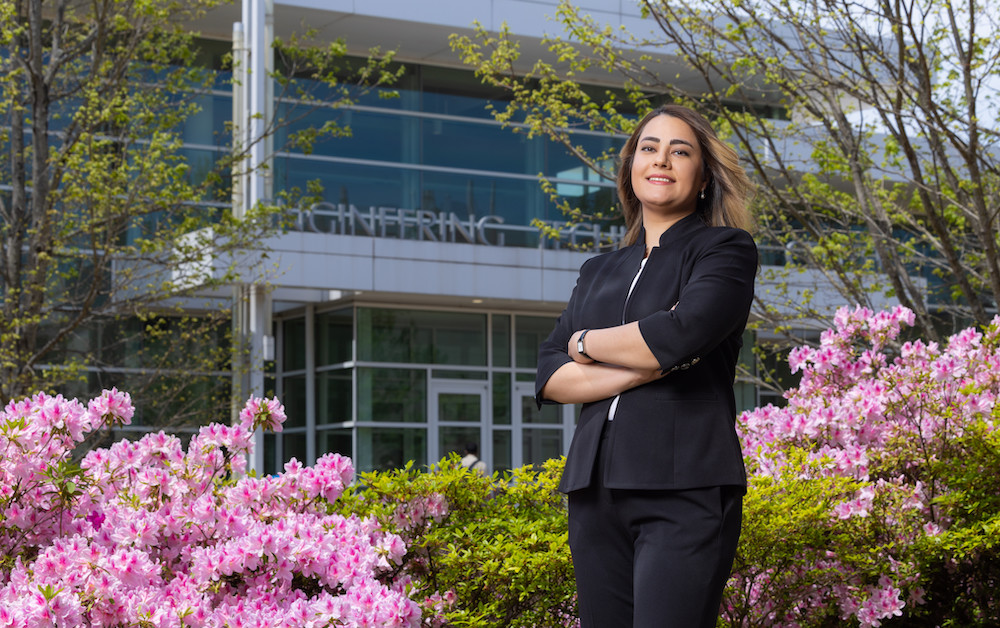Image above: Mfon Okpok at equipment panel
[This article by Gary Tanner was first published on the Kennesaw State University website, republished here with permission. The photos are by Matthew Yung and Darnell Wilburn]
As a teenager growing up in Calabar, Nigeria, Mfon Okpok first took apart his father’s television and then his radio. He was fascinated by the components inside them that worked together to produce the pictures and sound.
“From then until now, I’ve been very inquisitive,” he said.
That was the beginning of his interest in engineering and learning how things operate, leading to a career in broadcast technology and a lifetime of study.
Elsewhere in Iran, Mahdiyeh Soltaninejad’s father hoped she would grow up to become a physician to help others
“He never pushed me, but he saw it in me that I care about others and thought becoming a doctor must be a good profession for me in future,” Soltaninejad said. “When I was very young, he called me ‘doctor’ sometimes. I always had that in my mind, and I always thought that is my path.”
Instead, her high school teachers suggested her mastery of math meant she could be an outstanding engineer. By the time she entered the University of Tehran, Soltaninejad had decided to follow the path of her older sister, who is an industrial engineer.
This month, Okpok and Soltaninejad become the first two people to earn a doctorate in interdisciplinary engineering from Kennesaw State University’s Southern Polytechnic College of Engineering and Engineering Technology. The Ph.D. in Interdisciplinary Engineering degree program was launched in the fall of 2021.
Okpok successfully defended his doctoral dissertation in February, becoming the first to earn the degree, while Soltaninejad completed her dissertation defense in early April.
Okpok’s dissertation presented his research on advanced static image compression technology techniques. These techniques are based on vehicle count information obtained within the vicinity of roadside units. The goal of his research is to enable the transmission of public emergency safety messages, such as child abduction alerts, to the dashboards of vehicles in affected areas. This is particularly important given the constraints of hands-free laws and cellular data size limitations. His research applies these techniques within the context of connected vehicle networks.
Billy Kihei, research assistant professor of computer engineering and Okpok’s advisor, said he was well-prepared for the Ph.D. in Interdisciplinary Engineering program, pointing out he has previously earned master’s degrees in math, information technology, electrical engineering and software engineering, as well as working as a senior engineer in the broadcast technology industry.
“Mfon is a lifelong learner,” Kihei said. “When he brought his research thesis to me, it was obvious that it was new and had great potential to advance public safety.”

While Soltaninejad decided not to go into the practice of medicine, her engineering focus is on areas that can improve health, especially for children. Her doctoral dissertation complemented a research focus of her advisor, Christina Scherrer, a professor in the Department of Industrial and Systems Engineering.
“Mahdiyeh used statistical analysis and math modeling to examine ways to improve oral health of children,” Scherrer said. “Advising her has been a pleasure not only because her research is interesting and impactful, but she’s also a very intelligent and hard-working person.”
Both newly minted Ph.Ds said they would recommend the SPCEET doctoral program to others.
“Success in the program is determined by you as an individual. It’s all about you and your commitment,” Okpok said. “I can look back on this experience over the past three years and realize that I did a lot – I published six papers. And now I have earned the Ph.D.”
